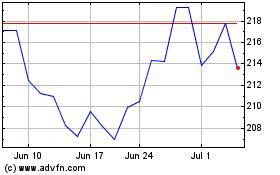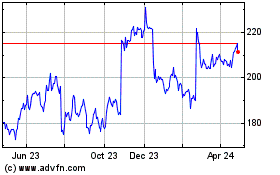By Katy Stech Ferek
WASHINGTON -- The nation's bankruptcy industry is bracing for a
wave of business collapses triggered by the coronavirus pandemic as
its ranks have been thinned by a decade of economic growth.
The slowed pace of corporate chapter 11 bankruptcy filings --
which crested in 2009 with 13,700 cases and has fallen to about
half that amount in recent years -- has led restructuring firms to
shed bankruptcy lawyers and advisers.
Now the firms are preparing for the rush.
O'Melveny & Myers LLP, Paul Hastings LLP, DLA Piper and
Sidley Austin LLP are among the law firms looking to hire
bankruptcy lawyers at locations across the country, said Dan
Binstock, a partner at Garrison & Sisson who is president of
the National Association of Legal Search Consultants.
Scott Love, a Washington, D.C.-based legal recruiter, calls it a
"frontier free-for-all," adding that "candidates that weren't that
attractive a year ago are now shining."
Restructuring advisory firms are staffing up too, including FTI
Consulting Inc., which began reassigning some of its corporate
finance professionals to handle distress work in March.
Even as firms shift resources, their pool of available talent is
shallow because the bankruptcy practice has been mostly at a lull
in recent years.
"That missing generation -- that's a real thing," said Thomas
Horan, a partner at the Fox Rothschild LLP law firm in Wilmington,
Del. "If you're looking for that midlevel associate who really
knows what they are doing, they are hard to find."
The financial crisis triggered a rise in business failures,
creating full demand for bankruptcy lawyers, restructuring advisers
and legal support businesses. But filings have declined since then,
leading to a contraction of the industry.
Corporate bankruptcy powerhouse Weil, Gotshal & Manges laid
off several dozen associates and more than 100 staffers in 2013,
citing the winding down of the Lehman Brothers bankruptcy case. Los
Angeles bankruptcy law firm Stutman, Treister & Glatt shut down
in 2014, leading some of its 25 lawyers to flee for other firms.
Other law firms with large bankruptcy practices have merged.
Shari Bedker, who manages several professional-development
nonprofits for bankruptcy lawyers and restructuring experts, said
she has watched promising young stars drop out of view in recent
years. She has also heard that fewer law students have been
studying bankruptcy because of what were perceived to be bleak job
prospects.
Doron Kenter, a 37 year old who worked on corporate bankruptcy
cases at several top law firms, left the field in 2017 for a
grant-making position at a Jewish nonprofit. He said that he might
have stayed if the industry had remained busy and that he saw other
colleagues use the extra time they had to look for jobs. "I felt
like I was getting stale," he said.
Amy Quackenboss, executive director of the American Bankruptcy
Institute, which represents more than 12,000 professionals, said it
is difficult to predict how many companies will file for chapter 11
bankruptcy protection, the type used by struggling companies to
survive.
Unlike unemployment claims, bankruptcy filings tend to be a
lagging indicator of economic health as business owners spend cash
and look for other ways to stay afloat. J.Crew Group Inc. and
Gold's Gym International Inc. were among the companies filing for
bankruptcy protection this week, and experts see many more
ahead.
Corporate chapter 11 filings increased to 560 new cases during
April, up 26% from 444 filings a year earlier, according to
legal-services firm Epiq Global.
Turnaround Management Association Chief Executive Scott Stuart
said the industry's ability to handle the influx of work will
depend on how quickly it can train newcomers who haven't
experienced an economic downturn to sharpen their skills needed to
guide U.S. companies through uncharted territory.
"It's a legitimate concern that the system is going to be
overwhelmed, but the system isn't going to collapse," said Mr.
Stuart, whose organization is providing extra training materials to
restructuring advisers.
A large portion of lawyers who specialize in big corporate cases
began their careers as young associates shortly after federal
lawmakers made sweeping changes to the bankruptcy code in 1978.
After the law changed, firms ordered younger lawyers to decipher
the new rules. Four decades later that class of lawyers is ready to
retire.
One in every three bankruptcy lawyers graduated in or before
1990, according to Massachusetts-based legal data provider Firm
Prospects LLC, which tracks about 2,200 law firms. For U.S. lawyers
overall, roughly one in every five lawyers graduated at that
time.
"That's a pretty big gap," said Adam Oliver, managing director
at the firm, who said he recalled another generational legal
transition when junior and midlevel lawyers for the real-estate
industry fled during the last recession.
Most of the corporate work will be concentrated in New York and
Delaware, despite several recent legislative efforts to force
companies to file in courtrooms closer to their headquarters. More
than 160 active and retired bankruptcy judges recently wrote a
letter to Congress in support of that requirement, saying
bankruptcies in faraway courts have disenfranchised workers and
local creditors while undermining the integrity of the U.S. court
system.
The expected uptick in bankruptcies will be a test for the
country's roughly 340 bankruptcy judges, most of whom were
appointed after the last peak of corporate filings.
Roughly 45% of the judges who were on the bench during the
depths of the last recession remain in the courts to handle the
next wave, according to a review of federal-court administrative
records and other documents by The Wall Street Journal. Judges are
appointed for renewable 14-year terms.
None of the judges in Wisconsin, Washington state and
Connecticut presided during the last recession. Only one of
Arizona's seven judges and one of Massachusetts's five judges
handled cases during the last rush.
Judicial inexperience has a high cost, according to a 2017 study
from researchers at Brigham Young University, the University of
Minnesota, Queen's University and the University of Illinois.
In that study of more than 100,000 chapter 11 bankruptcy cases
filed between 1993 and 2012, researchers found that corporate
bankruptcy cases assigned to less experienced judges spend more
time in court as those judges take longer to make decisions and
issue rulings.
It concluded that it takes an average of four years for a
bankruptcy judge to learn how to manage complex chapter 11 cases as
efficiently as their experienced colleagues.
Courtroom delays account for potentially billions of dollars in
extra legal fees, the study said.
A Massachusetts bankruptcy judge, Frank Bailey, was appointed
during the heat of the last recession and estimates that his own
learning curve took two years. He said that new bankruptcy judges
lean on each other for help and that the lull has led brighter
lawyers to the bench because private practice became less
lucrative.
"Most bankruptcy judges come to the bench with a lot of
experience, either on the business side or the consumer side, but
everyone has something to learn," he said.
Write to Katy Stech Ferek at katherine.stech@wsj.com
(END) Dow Jones Newswires
May 06, 2020 08:14 ET (12:14 GMT)
Copyright (c) 2020 Dow Jones & Company, Inc.
FTI Consulting (NYSE:FCN)
Historical Stock Chart
From Apr 2024 to May 2024

FTI Consulting (NYSE:FCN)
Historical Stock Chart
From May 2023 to May 2024
